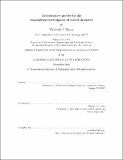| dc.contributor.advisor | Michael J. Cima. | en_US |
| dc.contributor.author | Zhang, Elizabeth Y. | en_US |
| dc.contributor.other | Massachusetts Institute of Technology. Department of Electrical Engineering and Computer Science. | en_US |
| dc.date.accessioned | 2019-07-15T20:30:33Z | |
| dc.date.available | 2019-07-15T20:30:33Z | |
| dc.date.copyright | 2018 | en_US |
| dc.date.issued | 2018 | en_US |
| dc.identifier.uri | https://hdl.handle.net/1721.1/121645 | |
| dc.description | This electronic version was submitted by the student author. The certified thesis is available in the Institute Archives and Special Collections. | en_US |
| dc.description | Thesis: M. Eng., Massachusetts Institute of Technology, Department of Electrical Engineering and Computer Science, 2018 | en_US |
| dc.description | Cataloged from student-submitted PDF version of thesis. | en_US |
| dc.description | Includes bibliographical references (pages 91-99). | en_US |
| dc.description.abstract | Chronically implantable probes are critical to investigating the neural dynamics of functions such as learning, motivation, and movement control over the extended timescales at which they develop. Proven functional lifetimes of over a year are also necessary for eventual clinical use in human patients to help monitor and treat certain neurological diseases. Existing electrochemical probes experience signal degradation and have not been reported to remain viable after 4 months of implantation. Chronic inflammatory and foreign body responses due to large implanted device size and mechanical mismatch are believed to be major contributors to signal degradation. In the first half of this thesis, I present the design of parylene-coated carbon fiber electrodes for electrochemical measurements that reduces implanted footprint by 2 orders of magnitude and flexural rigidity by 3 orders of magnitude compared to state-of-art electrochemical probes. | en_US |
| dc.description.abstract | The parylene-coated carbon fiber electrodes induced minimal chronic inflammatory responses that were not significantly distinguishable from unpenetrated control tissue. The novel microinvasive probes demonstrated stable subsecond measurement of extracellular dopamine neurochemicals for over 1 year. The second half of this thesis explores the effect of axial vibration during probe implantation to reduce experienced insertion forces. The greater compliance of microinvasive probes often preclude their successful implantation, particularly in deep brain regions. Current approaches temporarily encase probes in larger and stiffer guide tubes, for example, but these methods induce undesirable acute trauma that compromise long-term measurement performance. Dynamic implantation was found to significantly reduce in vitro insertion forces and significantly reduce acute in vivo tissue trauma hen compared to conventional static implantation. | en_US |
| dc.description.abstract | The extended chronic functionality of the parylene-coated carbon fiber electrodes and the reduced insertion forces generated during dynamic implantation enable future study of neuroplastic functions and the progression of neurodegenerative diseases in awake and behaving animals, and the findings further advance microinvasive probes towards clinical human use. | en_US |
| dc.description.statementofresponsibility | by Elizabeth Y. Zhang. | en_US |
| dc.format.extent | 99 pages | en_US |
| dc.language.iso | eng | en_US |
| dc.publisher | Massachusetts Institute of Technology | en_US |
| dc.rights | MIT theses are protected by copyright. They may be viewed, downloaded, or printed from this source but further reproduction or distribution in any format is prohibited without written permission. | en_US |
| dc.rights.uri | http://dspace.mit.edu/handle/1721.1/7582 | en_US |
| dc.subject | Electrical Engineering and Computer Science. | en_US |
| dc.title | Microinvasive probes for the longitudinal interrogation of neural dynamics | en_US |
| dc.type | Thesis | en_US |
| dc.description.degree | M. Eng. | en_US |
| dc.contributor.department | Massachusetts Institute of Technology. Department of Electrical Engineering and Computer Science | en_US |
| dc.identifier.oclc | 1098215700 | en_US |
| dc.description.collection | M.Eng. Massachusetts Institute of Technology, Department of Electrical Engineering and Computer Science | en_US |
| dspace.imported | 2019-07-15T20:30:30Z | en_US |
| mit.thesis.degree | Master | en_US |
| mit.thesis.department | EECS | en_US |
